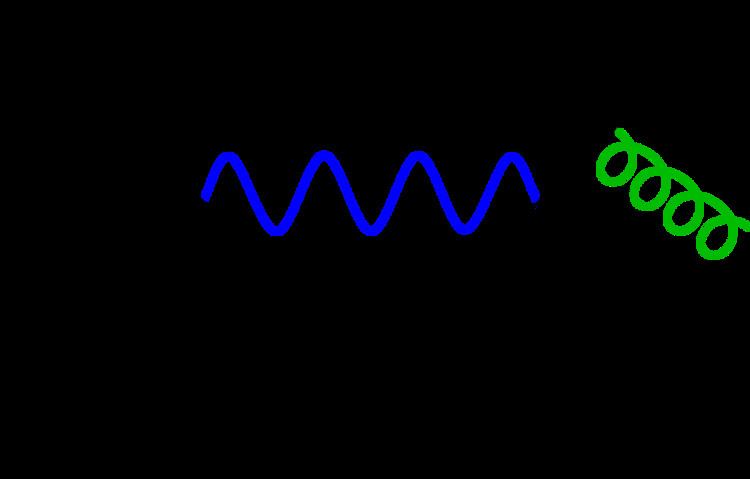 | ||
In theoretical particle physics, the gluon field strength tensor is a second order tensor field characterizing the gluon interaction between quarks.
Contents
- Definition
- Tensor components
- Differential forms
- Comparison with the electromagnetic tensor
- QCD Lagrangian density
- Gauge transformations
- Equations of motion
- References
The strong interaction is one of the fundamental interactions of nature, and the quantum field theory (QFT) to describe it is called quantum chromodynamics (QCD). Quarks interact with each other by the strong force due to their color charge, mediated by gluons. Gluons themselves possess color charge and can mutually interact.
The gluon field strength tensor is a rank 2 tensor field on the spacetime with values in the adjoint bundle of the chromodynamical SU(3) gauge group (see vector bundle for necessary definitions). Throughout, Latin indices (typically a, b, c, n) take values 1, 2, ..., 8 for the eight gluon color charges, while Greek indices (typically α, β, μ, ν) take values 0 for timelike components and 1, 2, 3 for spacelike components of four-vectors and four-dimensional spacetime tensors. Throughout all equations, the summation convention is used on all color and tensor indices, unless explicitly stated there is no sum to be taken.
Definition
Below the definitions (and most of the notation) follow K. Yagi, T. Hatsuda, Y. Miake and Greiner, Schäfer.
Tensor components
The tensor is denoted G, (or F, F, or some variant), and has components defined proportional to the commutator of the quark covariant derivative Dμ:
where:
in which
Different authors choose different signs.
Expanding the commutator gives;
Substituting
so that:
where again a, b, c = 1, 2, ..., 8 are color indices. As with the gluon field, in a specific coordinate system and fixed gauge Gαβ are 3×3 traceless Hermitian matrix-valued functions, while Gaαβ are real-valued functions, the components of eight four-dimensional second order tensor fields.
Differential forms
The gluon color field can be described using the language of differential forms, specifically as an adjoint bundle-valued curvature 2-form (note that fibers of the adjoint bundle are the su(3) Lie algebra);
where
A more mathematically formal derivation of these same ideas (but a slightly altered setting) can be found in the article on metric connections.
Comparison with the electromagnetic tensor
This almost parallels the electromagnetic field tensor (also denoted F ) in quantum electrodynamics, given by the electromagnetic four-potential A describing a spin-1 photon;
or in the language of differential forms:
The key difference between quantum electrodynamics and quantum chromodynamics is that the gluon field strength has extra terms which lead to self-interactions between the gluons and asymptotic freedom. This is a complication of the strong force making it inherently non-linear, contrary to the linear theory of the electromagnetic force. QCD is a non-abelian gauge theory. The word non-abelian in group-theoretical language means that the group operation in not commutative, that makes the corresponding Lie algebra non-trivial.
QCD Lagrangian density
Characteristic of field theories, the dynamics of the field strength are summarized by a suitable Lagrangian density and substitution into the Euler–Lagrange equation (for fields) obtains the equation of motion for the field. The Lagrangian density for massless quarks, bound by gluons, is:
where "tr" denotes trace of the 3×3 matrix GαβGαβ, and γμ are the 4×4 gamma matrices.
Gauge transformations
In contrast to QED, the gluon field strength tensor is not gauge invariant by itself. Only the product of two contracted over all indices is gauge invariant.
Equations of motion
The equations governing the evolution of the quark fields are:
which is like the Dirac equation, and the equations for the gluon field strength tensor are:
which are similar to the Maxwell equations (when written in tensor notation), more specifically the Yang–Mills equations for quarks and gluons. The color charge four-current is the source of the gluon field strength tensor, analogous to the electromagnetic four-current as the source of the electromagnetic tensor. It is given by
which is a conserved current since color charge is conserved. In other words, the color four-current must satisfy the continuity equation:
